
Yongin is a city in the Seoul Capital Area, the largest in Gyeonggi Province, South Korea. With a population over 1 million, the city has developed rapidly since the 21st century, recording the highest population growth of any city in the country. Yongin is home to Everland and Caribbean Bay, South Korea's most popular amusement and water parks. The city is also home to the Korean Folk Village, the largest of its kind. Yongin-si is a multi-nuclear city with multiple urban centers, not a single nuclear structure, and Giheung-gu crosses the Yeongdong Expressway and Dongbaek, while Suji-gu crosses Pungdeokcheon Stream and Jukjeon.
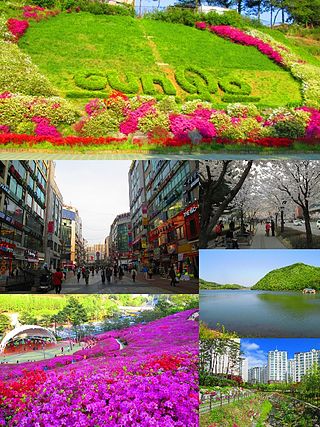
Gunpo, formerly romanized as Kunp'o, is a small city in South Korea's Gyeonggi Province, located south of Seoul in the Seoul National Capital Area. It borders Anyang to the north, Uiwang to the east, and Ansan to the south and west, and is connected to its neighbors and to Seoul by lines 1 and 4 of the Seoul Metropolitan Subway. Gunpo is also home to three stops on the Gyeongbu Line, a national railway that links it to the rest of the country. Although 73.2% of the city is greenspace, owing largely to Surisan and various smaller mountains, Gunpo is home to over 286,000 residents in several urban areas. The city's downtown core is Sanbon New Town, a commercial hub which centers on a pedestrian "street of culture" that Gunpo has designated as one of its eight scenic locations.

The Shinbundang Line Korean: 신분당선; Hanja: 新盆唐線; literally, New Bundang Line) or DX Line for Dynamic Express Line is a 33.4 km (20.8 mi) long line of the Seoul Metropolitan Subway. It is the world's fifth subway to run completely driverless and the second completely driverless metro line to open in South Korea, after Busan Subway Line 4. It connects Sinsa station and Gwanggyo station in 42 minutes, a feat achieved by being the first line to operate South Korea's next-generation subway car travelling at over 90 km/h (56 mph), with the fastest average speed of any subway line in the country.
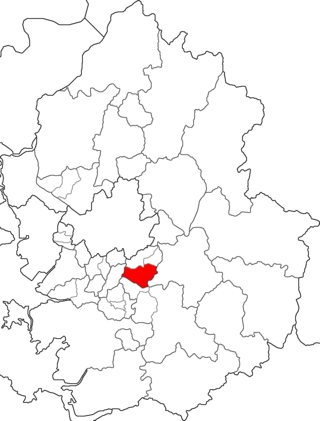
Bundang District (Korean: 분당구) is the largest and most populous district (gu) of Seongnam, a major city in the Seoul Capital Area, South Korea. Bundang District is one of South Korea's wealthiest and highest developed areas, being the nation's first and largest completely artificial city built in the early 1990s. Many high-rise luxury condos moved in the early 2000s, with a second planned city built in the late 2000s called Pangyo in the same district. Apartment prices are the second highest in Gyeonggi Province after Gwacheon and 7th highest nationwide, higher than many central Seoul districts such as Mapo District or Jongno District. Apartments around Pangyo station and the high-rise luxury condos around Jeongja station and Sunae station rival prices in the most expensive areas in the country. Unlike older cities such as Seoul, Bundang has no telephone poles overground, resulting in a clean cityscape with well-designed streets.
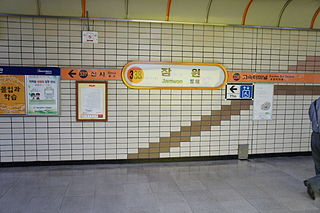
Jamwon Station (Korean: 잠원역) is a station on the Seoul Subway Line 3. It is located in Jamwon-dong, Seocho-gu, Seoul.
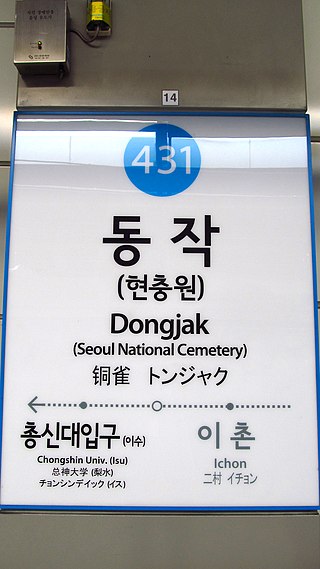
Dongjak Station is a station on Line 4 and Line 9 of the Seoul Subway. Express trains on Line 9 stop at this station. As the station's subname, This station serves the Seoul National Cemetery.

Sillim Station is a station on Seoul Subway Line 2 and the Sillim Line. It is located in Sillim-dong, Gwanak-gu, Seoul.

AREX is a South Korean airport rail link and commuter rail line that links Incheon International Airport with Seoul Station via Gimpo International Airport.

Seocho District is one of the 25 local government districts which make up the city of Seoul, South Korea. Seocho is a part of the Gangnam region, along with the Gangnam district of Seoul. Seocho District ranks as one of the richest neighborhoods in South Korea and among the most expensive areas in Seoul with an average sales price of 47.75 million South Korean won per 3.3 square meters. Many of the wealthiest residents are concentrated in the three Gangnam districts including Seocho, known as Gangnam School District Eight.

Geumjeong Station is a ground-level metro station on lines 1 and 4 of the Seoul Subway network in South Korea. The station is in Gunpo, a city approximately 15 km (9.3 mi) south of Seoul in Gyeonggi Province, between the cities of Anyang and Suwon. The name means that the land is covered with waves everywhere and that the water wets women's clothes.

Express Bus Terminal Station is a station on Seoul Subway Line 3, Line 7, and Line 9. The stations are located in the Greater Gangnam Area, Banpo-dong, Seocho District, Seoul, Korea.
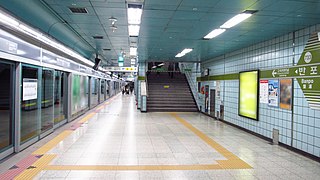
Banpo Station is a metro station on Seoul Subway Line 7 located in Jamwon-dong, Seocho District, Seoul. Despite its name, the station is not located in Banpo-dong, but instead in Jamwon. It has 6 entrances that they are all right side entrance and they have screen doors right before entering the train. It takes 4~8 minutes between 2 trains and next stations are Nonhyeon and Seoul Express Bus Terminal. It is only 500m long between Banpo station and two other Stations next to it. The station number is 733.
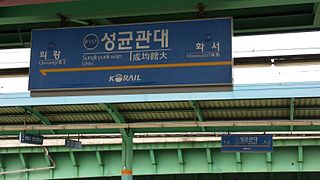
Sungkyunkwan University Station is a ground-level metro station on line 1 of the Seoul Subway in Yuljeon Dong, Jangan Gu, Suwon, South Korea. The station is nearby Sungkyunkwan University and Dongnam Health College. Travel time from Sungkyunkwan University Station to Seoul Station on Line 1 is 54 minutes, and travelling to Sungkyunkwan University's other campus, by Hyehwa Station in Seoul, takes 67 minutes, transferring to Line 4 at Geumjeong. The original station building was demolished, and a new, larger building incorporating shops, clinics, and a car park, was built, opening in late 2016.
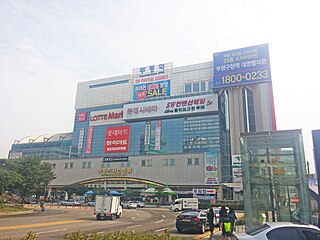
Bupyeong station is a subway station located in Bupyeong District, Incheon, South Korea. This station is on the Seoul Subway Line 1 and Incheon Subway Line 1. It is one of the busiest stations on the Incheon line because of its central location and its connection to the Seoul line.

Bupyeong District is one of the 10 administrative divisions that comprise Incheon, South Korea. Bupyeong District comprises an area of 12.35 square miles, and has a population of 508,587. It is located north of Namdong District, east of Seo District, and south of Gyeyang District. The city of Bucheon, in neighboring Gyeonggi Province, comprises its eastern limit.

Oido station is a subway station on Seoul Subway Line 4 and the Suin–Bundang Line in Siheung, South Korea. It is the current southwestern terminus of Seoul Subway Line 4 located almost 30 kilometers southwest of Seoul, connecting Oido to other parts of Korea. A commuter rail trip between this station and Seoul Station takes over an hour, and a train servicing depot is located nearby. The name of the station was decided by the surrounding area Oido island.

Gangdong Station is a station on Seoul Subway Line 5. The line branches off to the northeast and the southeast at this point, with Gil-dong station to the northeast and Dunchon-dong station to the southeast. Cheonho station precedes it on the west.

Seojeongni Station is a station in Seojeong-dong, Pyeongtaek, South Korea. Mugunghwa-ho trains running on the Gyeongbu Line stop here. Additionally, services on Seoul Subway Line 1 have been calling at this station since 2005. Its station subname is Kookje College.

Juan station is a subway station on the Seoul Metropolitan Subway Line 1 and Incheon Subway Line 2. This station receives the second-highest number of crowds along the entire Incheon line due to its proximity to the downtown area. It is also near Inha University and Inha Technical College.
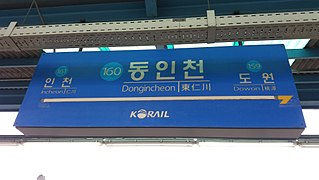
Dongincheon Station is a railway station on Seoul Metropolitan Subway Line 1 and Gyeongin Line located in Inhyeon-dong, Jung District, Incheon. Upon its opening in 1899, the station was known as "Chukhyeon Station", and in 1955, received its current name. The subway service started in 1974.





















